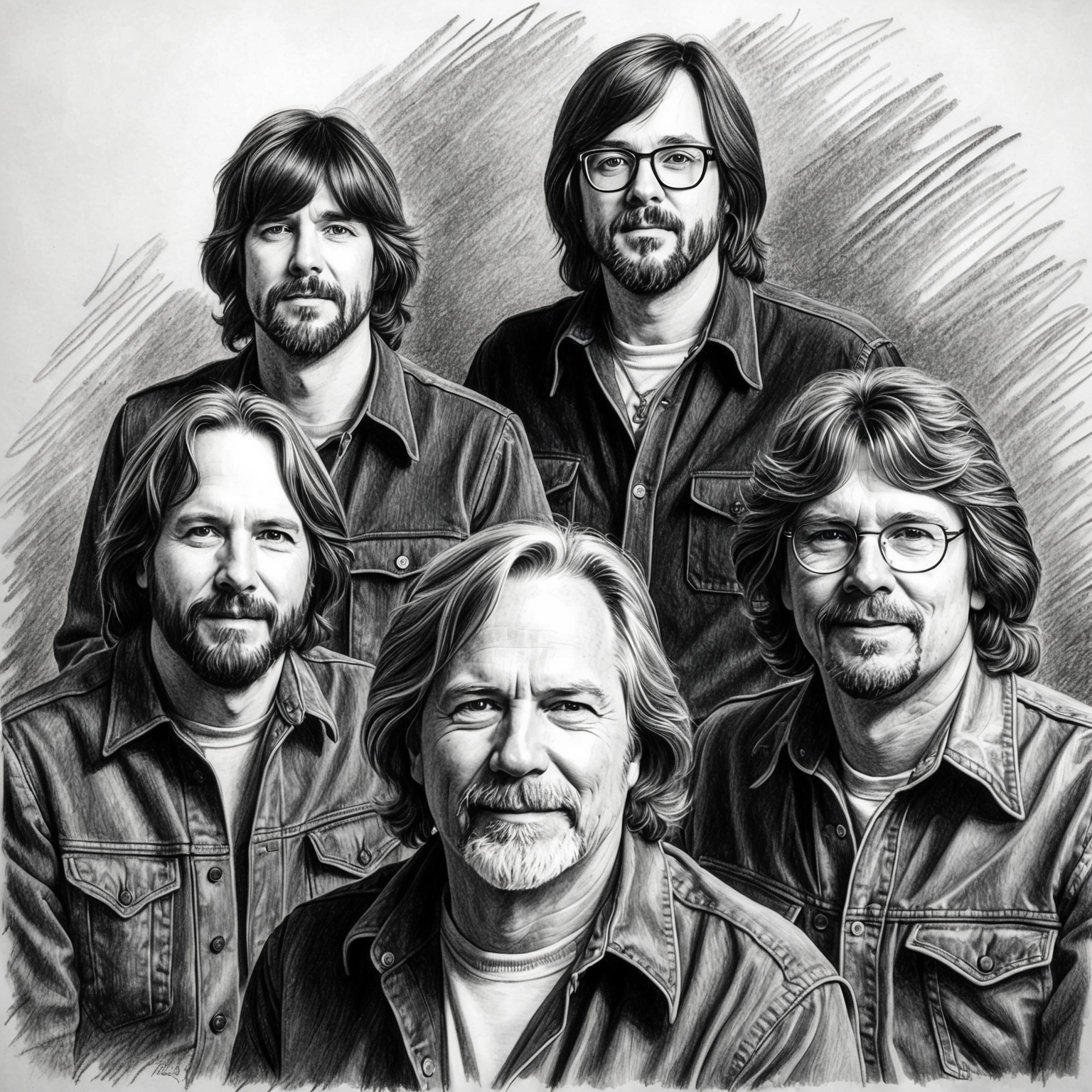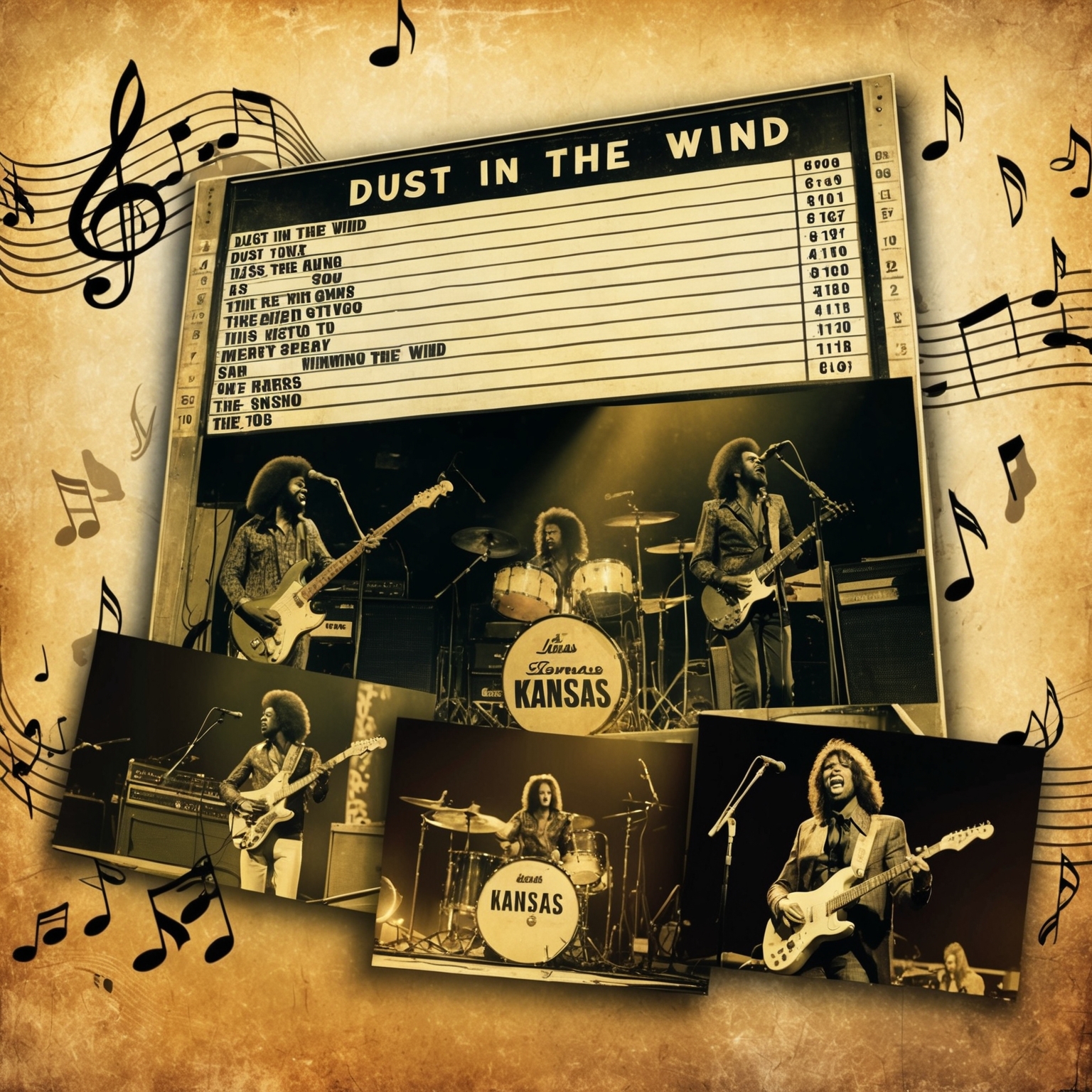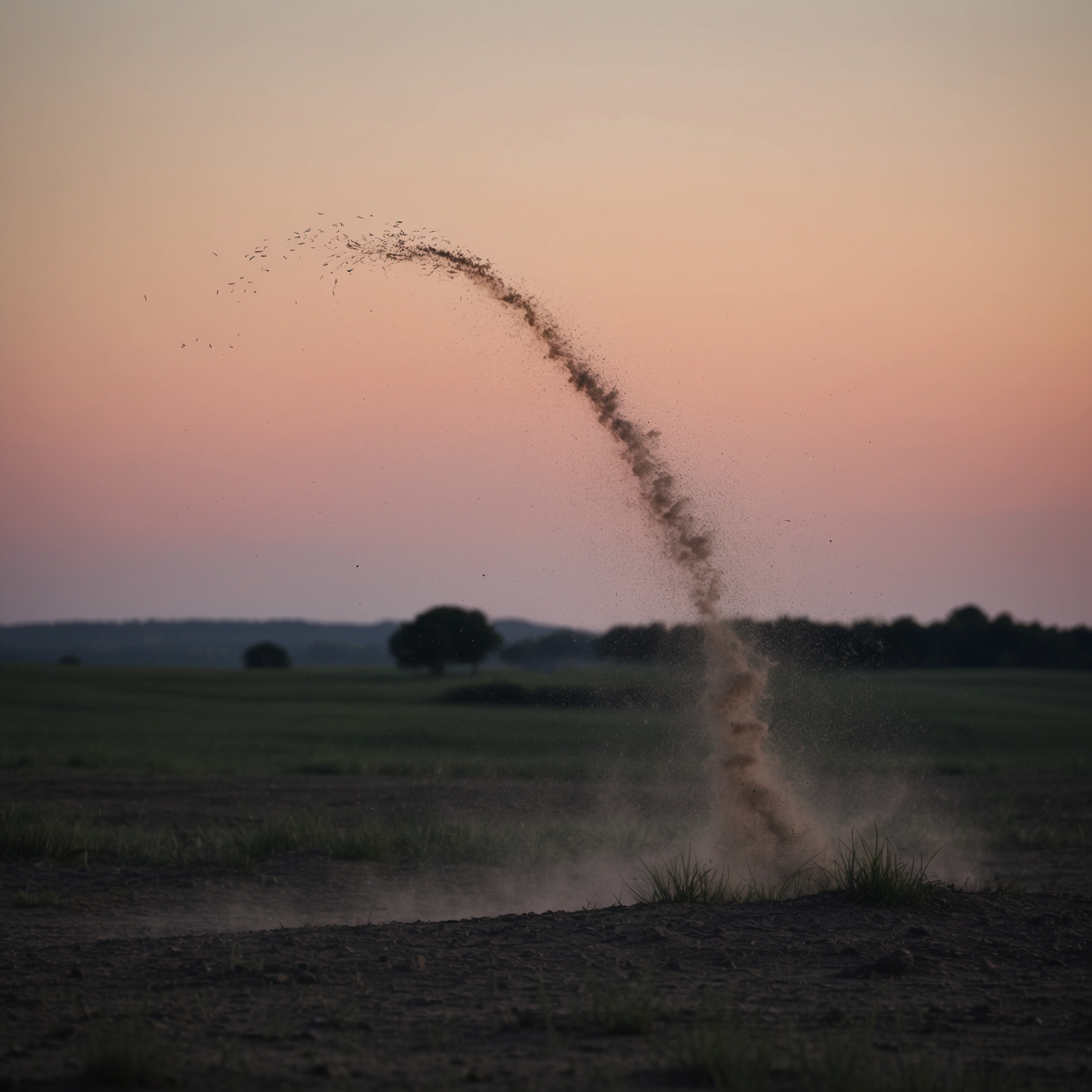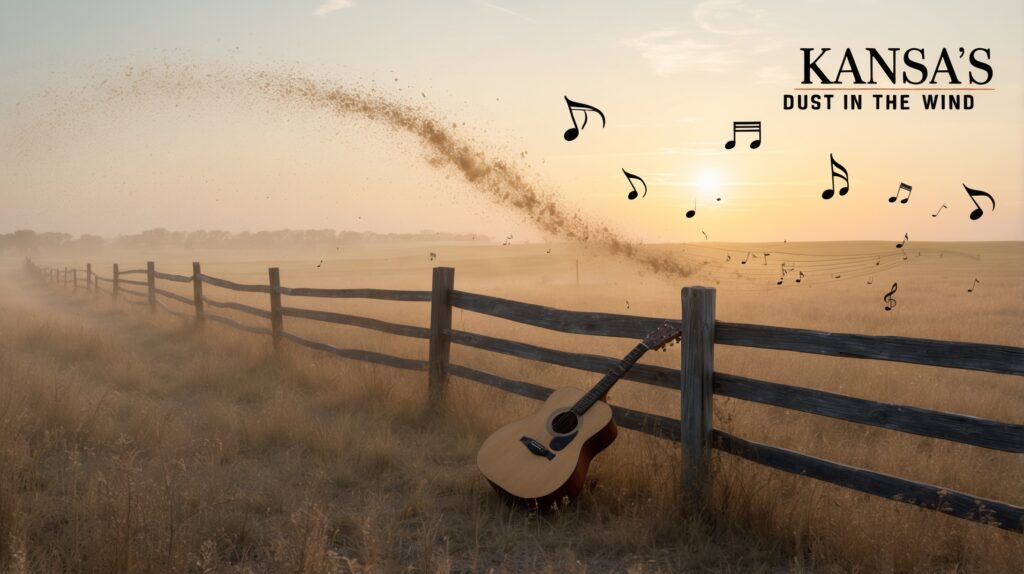Unraveling the Mystical Saga of Kansas
“Dust In The Wind” marked a significant chapter in the storied career of Kansas, a band known for their progressive rock sound. With this song, they skilfully intertwined introspective lyrics and acoustic melodies, capturing the soul of 1970s rock with a fresh sensibility.

Kansas, an American rock band that etched their unique mark in the world of rock music, has mesmerized audiences for decades. The release of “Dust In The Wind” symbolizes a high point in the band’s career, drawing a delicate blend of introspective lyrics and mesmerizing acoustic soundscapes into their repertoire. Formed in 1973 in Topeka, Kansas, the band initially started as a conglomerate of high school friends with a penchant for avant-garde rock, eventually evolving into one of the defining progressive rock acts of the 1970s.
At the heart of Kansas’s unique sound was a group of incredibly talented musicians, including Steve Walsh, Robby Steinhardt, Rich Williams, and Kerry Livgren, the latter of whom composed the timeless classic “Dust In The Wind.” The song emerged during a particularly creative period for the band, nestled between the success of their previous hits and a growing hunger within the band for more acoustic representation alongside their typical rock passion. Remarkably, Livgren stumbled upon the main riff for “Dust In The Wind” while playing finger exercises on his acoustic guitar, revealing how serendipitous and organic the band’s creative process could be.
When “Dust In The Wind” was released in 1977, it marked a distinct shift from the band’s traditional progressive rock ethos to embrace a more stripped-down and reflective sound. The music scene at that time was dominated by an eclectic mix of rock, punk, and disco, yet Kansas managed to captivate audiences with their unique fusion of art rock and philosophical musings. As the song climbed up the charts, it underscored Kansas’s ability to effortlessly transition and innovate, ensuring their status as one of America’s most beloved rock bands.
The Creative Mind Behind ‘Dust in the Wind’
Discover the creator of ‘Dust in the Wind,’ Kerry Livgren, whose musical brilliance shaped the sound of Kansas and extended the song’s philosophical reach.

The brilliance of ‘Dust in the Wind’ lies not only in its poignant lyrics but also in its haunting melody, crafted by the talented Kerry Livgren. As a key member of the progressive rock band Kansas, Livgren’s contributions have been pivotal in shaping the band’s unique sound that blends elements of rock, classical, and folk music. Born in Topeka, Kansas, Livgren’s early exposure to music was diverse, and he exhibited a flair for musical composition from a young age. His eclectic tastes and broad musical interests contributed to his reputation as a versatile and thoughtful composer.
Kerry Livgren’s musical style is imbued with influences from various genres, including rock, symphonic music, and world music. His compositions often feature complex structures and rich harmonies, exemplified in many Kansas hits. Livgren was instrumental in incorporating inspirational and philosophical themes into his songwriting, often drawing from his personal journey and reflections. This multidimensional approach to music composition is central to the enduring appeal of ‘Dust in the Wind.’
Collaborations played a key role in Livgren’s career, especially with his fellow band members of Kansas. The synergy between Livgren and the rest of the band allowed his compositions to flourish, seamlessly integrating with the dynamic arrangements that Kansas is known for. Specifically, with ‘Dust in the Wind,’ his collaboration with the band’s lead vocalist Steve Walsh was crucial in realizing the song’s full emotional potential, bringing Livgren’s introspective lyrics and gently flowing melody to life in a way that resonated deeply with listeners.
Honors, Covers, and Cultural Footprints
Dust in the Wind by Kansas is celebrated for its impactful covers, media appearances, and recognition as a rock classic.

Dust in the Wind by Kansas is more than just a song; it’s a timeless classic that has garnered critical recognition, found its way into numerous cultural staples, and inspired artists worldwide to reinterpret its poignant message. Its journey through time is a testament to its profound impact.
Despite not picking up any major awards when it was first released, Dust in the Wind has earned a host of accolades that underscore its enduring appeal. In 1998, it received a BMI Million-Air award, indicating it had been played over one million times on radio. The song is frequently listed among the greatest rock ballads, notably by outlets that explore the history and influence of classic rock music. While the track didn’t snag Grammys or American Music Awards, its perpetual presence on classic rock radio speaks volumes about its significance.
Cover versions of Dust in the Wind are plentiful, as its haunting melody and universal lyrics have captivated musicians across genres. Notably, artists like Sarah Brightman, Will Ferrell (in comedic tribute), and even Christian band Sisters of Glory have infused new life into this classic, bridging genres from rock to operatic and gospel to comedy. Each reinterpretation brings a new perspective, further cementing the song’s legacy.
Popular media has also embraced Dust in the Wind. It has featured in movies such as 2001’s “Old School,” starring Will Ferrell, and it can be found in TV episodes of shows like “The Office” and “Highlander: The Series.” The song’s reflective themes and evocative sound have made it a favorite for scenes requiring emotional depth. Regardless of the accolades it may lack in traditional award shows, the song’s presence in widespread media underscores its deep connection with audiences everywhere.
Climbing the Charts: The Meteoric Rise of ‘Dust in the Wind’
Discover how Kansas’ ‘Dust in the Wind’ achieved remarkable chart success, etching its mark in music history by standing out on the ’70s charts with its introspective charm.

Released in January 1978, ‘Dust in the Wind’ by Kansas quickly established itself as a remarkable chart success. The song was featured on their album Point of Know Return and reached its peak chart position at number 6 on the Billboard Hot 100 in April 1978. This achievement made it one of Kansas’ most successful singles to date. At a time when disco tunes dominated the airwaves, ‘Dust in the Wind’ offered a soulful and introspective counterpoint, captivating audiences with its poignant themes and acoustic simplicity.
In comparison to other tracks in the charts during its release, ‘Dust in the Wind’ stood out for its distinctive melodic structure and philosophical lyrics. While other bands were embracing the electric, high-energy vibe of the ’70s, Kansas’ ballad demonstrated the band’s versatility and ability to craft timeless music. The song’s success on the charts highlighted Kansas as a band capable of both progressive rock anthems and stirring acoustic compositions, thus solidifying their standing in the rock genre.
This particular track was not the first hit for Kansas, yet it represented a significant moment in their musical journey. As a follow-up to the band’s earlier notable successes like ‘Carry On Wayward Son,’ ‘Dust in the Wind’ contributed to defining Kansas’ identity in the industry. It showcased a facet of their artistry that was introspective and universally relatable, cementing their legacy as creators of music that transcends time. Moreover, the song’s chart success underscored Kansas’ ability to remain relevant amidst the changing musical landscape of the late ’70s.
Visual Journey: Kansas’ ‘Dust in the Wind’
Explore how Kansas’ ‘Dust in the Wind’ has been visually interpreted through fan videos and live performances that echo the song’s timeless themes.

Although the original release of Kansas’ ‘Dust in the Wind’ did not come with an official music video—considering it was released in 1977, before the MTV era—there are still ways this iconic song has been visually interpreted. Fans of Kansas and ‘Dust in the Wind’ have taken it upon themselves to create various fan-made videos and live performance footage that encapsulate the essence of this timeless track.
One common theme in many fan videos is a focus on nature and the passage of time—concepts central to the song’s lyrics. These videos often depict scenes of flowing rivers, drifting leaves, and sunsets to drive home the song’s meditation on mortality and ephemerality. These artistic interpretations offer a modern lens through which to experience the song’s emotional depth and have contributed to ‘Dust in the Wind’s continued relevance several decades after its release.
Kansas themselves have contributed live performances that add a visual dimension to the song. These performances highlight the musicianship of Kansas and offer an engaging way for audiences to connect with the song beyond its well-known melody and lyrics. The stage presence, renditions, and pure emotion displayed during these live versions provide a captivating interpretation that resonates strongly with fans and music enthusiasts alike.
The Architectural Harmony of ‘Dust In The Wind’
Dust in the Wind’ showcases Kansas’s ability to transition from their usual progressive rock style to a poignant acoustic ballad, structured with a simple yet emotionally profound melody, harmony, and rhythm.

At first glance, ‘Dust in the Wind’ by Kansas appears deceptively simple, yet its musical structure is a masterclass in composition. Written in the key of C major, the song leans on a delicate balance of fingerpicked guitar lines that create its hypnotic rhythm. Its tempo is moderate, clocking in around 6/8 timing, which allows for its reflective nature to shine. This signature picking pattern, performed on a 12-string guitar, gives the song its ethereal sound, enveloping the listener in a sense of introspection and melancholy.
One of the intriguing aspects of ‘Dust in the Wind’ is its chord progression. The song primarily revolves around a vi-IV-I-V progression, which is common in creating a hauntingly familiar and emotional resonance. The melody is simple yet profound, embodying a mournful yet tender feel throughout, beautifully harmonized by the band’s vocal arrangements. The harmony provides a lush undercurrent, allowing the narrative of the lyrics to be both intimate and universal.
In terms of instrumentation, the acoustic guitar takes center stage, accompanied by a haunting violin that underscores the song’s poignant theme. The absence of drums is a deliberate choice, emphasizing the track’s acoustic purity and allowing each nuanced note to ring through clearly. A gentle orchestral sweep enhances the track’s reflective tone, creating a sonic landscape that mirrors the song’s lyrical exploration of existential themes.
When compared to Kansas’s broader discography, ‘Dust in the Wind’ is distinctive for its stripped-down approach, diverging from the progressive rock compositions typical of the band during the 1970s. Previous works like ‘Carry On Wayward Son’ leaned heavily on electric guitars and complex musical structures, reflecting the band’s evolution toward more accessible and introspective material. The song signifies Kansas’s ability to pivot from grandiose arrangements to minimalist yet powerful storytelling, revealing a maturity in their artistic direction.
Interestingly, ‘Dust in the Wind’ was recorded in the iconic Woodland Sound Studio in Nashville, Tennessee, under the production expertise of Jeff Glixman. An anecdote from the session suggests the song was initially composed as a finger exercise by guitarist Kerry Livgren, and its profound impact was a surprise even to him. This song, with its stripped-back arrangement, became one of the band’s most enduring hits, proving that sometimes simplicity can be the ultimate sophistication.
Exploring the Ephemeral Nature of Existence in ‘Dust in the Wind’
Kansas’ ‘Dust in the Wind’ engages listeners with its introspective lyrics, exploring themes of mortality and the transience of life through poignant metaphors and an intimate narrative style.
Only for a moment and the moment’s gone
All my dreams
Pass before my eyes with curiosity
Dust in the wind
All they are is dust in the wind
Same old song
Just a drop of water in an endless sea
All we do
…
******* This Lyrics is NOT for Commercial use *******
 Lyrical Themes and Messages: At its core, ‘Dust in the Wind’ by Kansas explores the transient nature of human existence and the inevitability of life’s fleeting moments. The lyrics are deeply philosophical, drawing the listener into a contemplative state about mortality and the meaning of life. The song’s repeated refrain, “All we are is dust in the wind,” drives home the theme of impermanence, prompting listeners to reflect on their own lives and legacies. Released in the late 1970s, a period marked by significant cultural and political upheaval, these themes resonated profoundly with audiences seeking introspection amidst the chaos.
Lyrical Themes and Messages: At its core, ‘Dust in the Wind’ by Kansas explores the transient nature of human existence and the inevitability of life’s fleeting moments. The lyrics are deeply philosophical, drawing the listener into a contemplative state about mortality and the meaning of life. The song’s repeated refrain, “All we are is dust in the wind,” drives home the theme of impermanence, prompting listeners to reflect on their own lives and legacies. Released in the late 1970s, a period marked by significant cultural and political upheaval, these themes resonated profoundly with audiences seeking introspection amidst the chaos.
Narrative and Storytelling: The song’s narrative style is introspective, written from a first-person perspective that creates an intimate connection with the listener. It feels less like a story and more like a meditation or a diary entry, inviting listeners to share in a moment of realization. The contemplative tone and simple, yet profound, phrasing allow the message to transcend the specifics of any single story, making it universally relatable. This approach contributes to the song’s enduring impact, as it encourages personal reflection across different contexts.
Use of Literary Devices: Kansas employs a range of literary devices to enhance the lyrical quality of ‘Dust in the Wind.’ The song opens with vivid imagery – “I close my eyes / Only for a moment and the moment’s gone” – that captures the ethereal passage of time. Metaphors are layered throughout, particularly in the comparison of human life to “dust in the wind” and “a drop of water in an endless sea.” These metaphors effectively convey the insignificance of individual moments within the vastness of time and existence, while also invoking a sense of poetic melancholy. The natural imagery woven into the lyrics – the wind, the sea – evokes a connection to the world, grounding the existential musings in a tangible sensory experience.
Emotional Impact and Relatability: Emotionally, the lyrics of ‘Dust in the Wind’ strike a chord by prompting introspection and evoking a sense of vulnerability. This timeless contemplation on life’s impermanence encourages listeners to consider what truly matters, offering both solace and a call to make the most of the present. The song’s ability to evoke such profound emotions likely contributed to its lasting popularity, appealing to generations who find beauty in its earnest simplicity.
🎸 Did you know? Dust In The Wind by #Kansas was inspired by finger exercises! This chart-topping classic proves practice makes perfect! 🌬️✨ #RockTrivia #MusicMagic #70sVibeshttps://bit.ly/3YmRSy2 https://bit.ly/3YmRSy2
Click to Tweet







